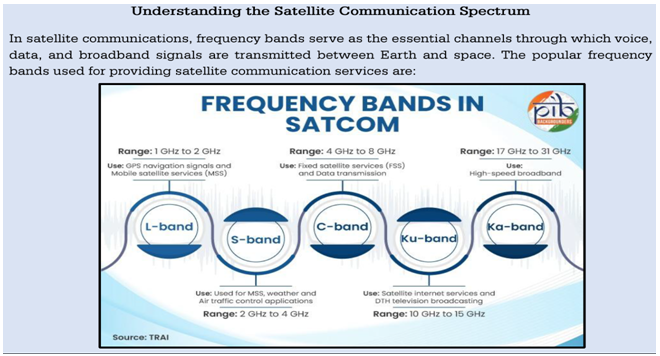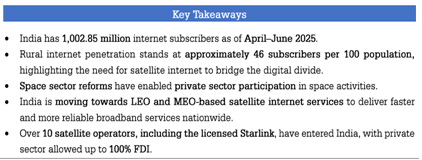

24th September 2025 (14 Topics)
Context:
India is expanding its satellite communication ecosystem with recent GSAT launches, reforms in licensing of GMPCS services, and promotion of private participation through IN-SPACe.
Satellite Communication as a Driver of Digital India
Introduction
- Satellite communication (Satcom) plays a crucial role in ensuring connectivity across remote, rural, and border areas where terrestrial networks are inadequate.
- With the rise of digital infrastructure requirements, Satcom is emerging as a vital pillar of Digital India and BharatNet projects.
India’s Satellite Communication Ecosystem
- Government Agencies
- ISRO: Development and launch of GSAT series for communication services.
- Department of Telecommunications (DoT): Licensing and regulatory framework.
- IN-SPACe: Facilitates private sector participation.
- Key Satellites
- GSAT-11, GSAT-19, GSAT-29, GSAT-N2: Provide broadband, DTH, VSAT, and high-throughput satellite (HTS) services.

Recent Developments
- GMPCS Licensing: Approval for global mobile personal communication by satellite (GMPCS) operators to provide broadband and voice services.
- Private Participation: IN-SPACe enabling start-ups and companies to utilize ISRO infrastructure.
- Policy Push: TRAI recommendations on licensing reforms (2023) to streamline spectrum allocation.
- Integration with BharatNet: Use of Satcom for last-mile connectivity in uncovered villages..

Applications of Satcom in India
- Telecommunication: Broadband, voice, DTH, and backhaul connectivity.
- Education & Health: Digital classrooms, telemedicine in rural areas.
- Governance & Security: Disaster management, armed forces communication, border connectivity.
- Commercial Uses: Aviation, shipping, IoT, and enterprise solutions.
|
Government Initiatives for Inclusive Digital Connectivity 1. Digital Bharat Nidhi (DBN)
2. Comprehensive Telecom Development Plan (CTDP)
3. National Broadband Mission (NBM) 2.0
|
Challenges in Satellite Communication
- High Cost: Launch and bandwidth leasing costs remain expensive.
- Spectrum Allocation Issues: Regulatory delays and policy bottlenecks.
- Technological Dependence: Reliance on foreign satellites for certain high-throughput services.
- Competition with 5G/terrestrial networks: Integration challenges between Satcom and ground-based telecom.
Way Forward
- Policy Reforms: Expedite Satcom policy for spectrum pricing and licensing clarity.
- Indigenous Capability: Expand GSAT and HTS fleet to reduce foreign reliance.
- Public-Private Partnerships: Encourage start-ups via IN-SPACe and production-linked incentives (PLI).
- Integration with 5G/6G: Develop hybrid Satcom-terrestrial architecture for nationwide coverage.
- International Collaboration: Leverage partnerships with global players for technology transfer and innovation.
More Articles

